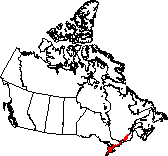|
Location
| Climate | Geology and geography
| Flora and fauna | Humans | Images
Location
The Mixedwood Plains extends along the Quebec City-Windsor corridor,
including the densely-populated region of southern Ontario.
Climate
Smallest of the ecozones, the Mixedwood Plains is nonetheless home to
half of Canada's population. Its cool winters (average temperature -5ºC)
and warm summers (average temperature 17ºC) are prone to highly changeable
weather, as the ecozone is in one of the major storm tracks of North
America.
Geology
and Geography
Plains and gently rolling hills are found here. Several major waterways
and lakes, from three of the great lakes to the St. Lawrence river and
its tributaries, dominate much of the region. Deposits from ancient
water bodies and glaciers make the soil here the most productive in
Canada. Carbonate-rich Paleozoic bedrock characterizes the geology of
the Mixedwood Plains.
Flora
and Fauna
Plants
Urbanization and agriculture have reduced the ancient forests drastically.
A mix of coniferous and deciduous trees are found here. Some of the
coniferous trees include white
pine, red pine,
eastern hemlock,
black spruce,
eastern red cedar,
and eastern white
cedar. Sugar
maple, red maple,
striped maple,
silver maple,
red oak, white
oak, chestnut
oak, chinquapin
oak, white elm,
slippery elm,
yellow birch,
paper birch,
black walnut,
butternut, eastern
cottonwood, trembling
aspen, balsam
poplar, basswood,
blue ash, black
ash, sassafras, tulip
tree, sycamore,
cucumber-tree,
shagbark hickory,
bitternut hickory,
red mulberry,
and Kentucky coffee-tree
are some of the deciduous trees. Other plants include the downy
serviceberry.
Animals
Mammals
The largest carnivores in the ecozone are the black
bear, wolf
and bobcat,
while the large herbivores are the moose
and white-tailed
deer. The smaller carnivores that can be found include coyote,
muskrat,
raccoon,
skunk,
red fox, and
river otter.
Some of the smaller herbivores here are the grey
squirrel, black
squirrel, red
squirrel, southern
flying squirrel, eastern
cottontail, snowshoe
hare, beaver,
white-footed mouse,
southern bog lemming,
and groundhog
(woodchuck). The only marsupial is the opossum.
Various whales, including the beluga,
can be seen in the waters of the St-Lawrence seaway.
Birds
Characteristic birds of prey include red-shouldered
hawk, cooper's
hawk, broad-winged
hawk, northern
goshawk, screech
owl, northern saw-whet
owl, short-eared
owl, long-eared
owl, and turkey
vulture. Among the numerous songbirds are the red-winged
blackbird, grasshopper
sparrow, Baltimore
oriole, Carolina
wren, ruby-throated
hummingbird, cedar
waxwing, whip-poor-will,
Henslow’s sparrow,
purple finch, cardinal,
blue jay,
brown creeper,
and sedge wren.
Some of the birds of the forest include ruffed
grouse, wild
turkey, northern
flicker, northern
bobwhite, wood
thrush, mourning
dove, downy woodpecker,
red-headed woodpecker,
and pileated woodpecker.
Waterfowl include Canada
goose, green
heron, great
blue heron, American
black duck, wood
duck, northern
pintail, blue-winged
teal, and mallard.
Some of the shorebirds are the spotted
sandpiper, upland
sandpiper, american
bittern, common
snipe, killdeer,
black tern, and
yellow rail.
Reptiles and Amphibians
Many species of reptiles and amphibians are found here. The frogs
and toads that live in the Mixedwood Plains include the tetraploid
gray treefrog, striped
chorus frog, northern
leopard frog, wood
frog, bullfrog,
green frog, pickerel
frog, American
toad, and spring
peeper. Several salamander and newt species, such as the
mudpuppy, eastern
newt, blue-spotted
salamander, Jefferson
salamander, yellow-spotted
salamander, and eastern
redback salamander, live here. Eight species of turtles are common
to the area, including stinkpot,
common snapping turtle,
common snapping turtle,
wood turtle, map
turtle, spotted
turtle, spiny softshell,
blanding's turtle,
and painted turtle.
The most common snake is the eastern
garter snake, but other snakes include eastern
ribbon snake, Butler's
garter snake, northern
water snake, redbelly
snake, smooth green
snake, ringneck
snake, brown snake,
eastern hognose snake,
massasauga, and
queen snake. The
sole lizard is the five-lined
skink.
Fish
The large number of introduced fish is largely the result of shipping
and canals, which have allowed invasive species to move through the
area. Lampreys are the most famous of the invasive fish in the Great
Lakes. Predatory fish in the waters of the area include lake sturgeon,
longnose gar, walleye, bowfin, white perch (introduced), brown trout,
brook trout, lake trout, common carp (introduced), Atlantic tomcod,
northern pike, muskellunge, and largemouth bass. They prey on such fish
as the cisco (lake herring), lake whitefish, central mudminnow, and
golden shiner. The anadramous fish, who live in the ocean but come into
freshwater to breed, include kokanee (sockeye) salmon, rainbow smelt
(introduced), alewife, sea lamprey (introduced), American brook lamprey,
silver lamprey, and northern brook lamprey.
Molluscs
The molluscs include the brown
mystery snail, valve
snail, ordinary
spire snail, river-bank
looping snail, great
lakes horn snail, oval
lake-limpet, black
sand-shell, eastern
elliptio, and olive
hickory-nut. The zebra mussel, a relatively recent invader, has
caused widespread damage to natural and human systems in the Great Lakes.
Insects
Some of the insects found here are the German
cockroach, American
cockroach, eastern
metallic green wood borer, red
turpentine beetle, european
earwig, boreal
spittlebug, silver-spotted
skipper, spring
azure, american
copper, monarch
butterfly, mourning
cloak, eastern
black swallowtail, european
mantis, migratory
grasshopper, and walking
stick.
Humans
Half of Canada's population lives here, and it contains the country's
two largest cities, Toronto and Montreal. Agricultural land is steadily
being covered by cities, and the population density has led to some
of the highest levels of pollution in the country. Ecological degradation
is extensive, due to industry and the population size. Many species
have been introduced to the ecozone and some, most notably the sea lamprey
and zebra mussel, are very detrimental to other species.
Images
Niagra
Falls, Ontario
 

|
|







